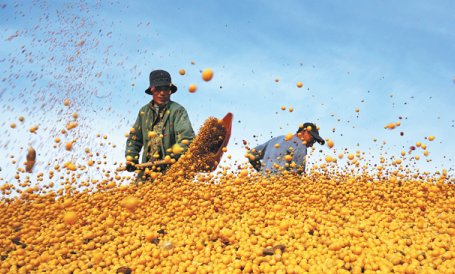Map of soybeans reveals best types, region by region

Researchers from the Chinese Academy of Agricultural Sciences recently mapped the geographic distribution of soybean nutritional composition in China.
Researchers believe that the study, which was published in the journal Food Research International, provides scientific evidence for guiding the creation of high-quality soybean production centers in the country.
As a major food crop, soybeans are grown across a broad swathe of China. Taking into account considerable variations in environmental conditions, farmers use a variety of seed types in different regions, according to Han Tianfu, a researcher at the Institute of Crop Sciences at the CAAS.
However, the geographical distribution pattern of soybean quality had been unclear for a long time, due to the lack of large-scale sampling and multi-trait analysis data from actual production locations, Han said.
To clarify the spatial pattern of soybean seed typology, researchers collected 1,792 soybean samples from a vast range of areas across 29 provincial-level regions between 2010 and 2017.
By quantifying and analyzing the crude oil, protein and 11 categories of functional components of the samples, researchers were able to create a geographical distribution map of the different nutrients contained in soybeans. According to Han, the map presented a clear increasing trend in crude protein and dietary fiber from north to south, and a decreasing trend in crude oil, phospholipids (which provide protection against environmental factors), saponins (which give the bean a bitter taste) and carotenoid pigments.
In addition, soybeans with a high level of oligosaccharide (which render the beans slightly sweeter) were found to be concentrated in the central region.
Based on the nutrient distribution map, weather conditions and cultivation systems, researchers divided soybean production areas into three regions and 10 subregions. They then proposed a regionalization scheme of soybean seed quality to support high-quality edible soybean production.
According to Han, the northern part of China's northeast has a unique advantage when it comes to growing edible soybeans, and a focus on producing edible raw soybean products such as milk, tofu and bean sprouts was advisable in this region.
Meanwhile, the central and southern parts of the northeast are suited to grow high-oil, high-yield soybeans, so establishing a concentrated production area for high-oil soybeans to enhance national self-sufficiency was the best course of action.
As to the southern part of the region, the soybeans there have high protein content, so they should be used as a raw material for protein processing, the researcher added.
Xinhua

Today's Top News
- China pays its respects to 30 war martyrs
- Nation honors fallen soldiers returned from South Korea
- Equal consultation with mutual respect right way to settle TikTok issue
- Aid program must return to its roots
- UN Security Council slams deadly strikes in Qatar
- Trump to meet Qatari PM in New York






























